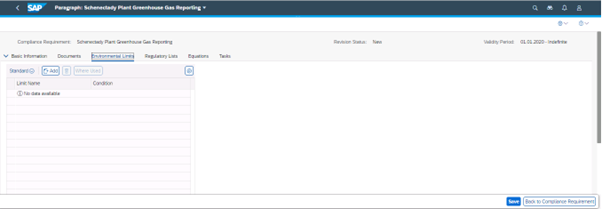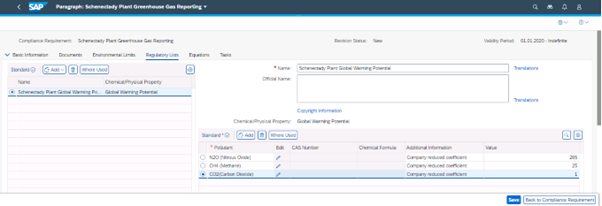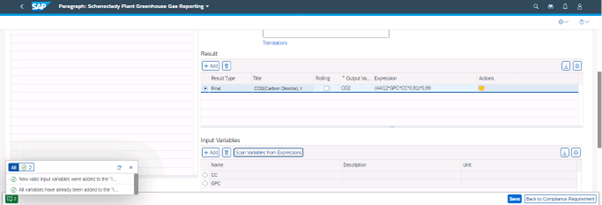
- SAP Community
- Products and Technology
- Product Lifecycle Management
- PLM Blogs by Members
- SAP S/4HANA EHS : Environment Management (Emissio...
Product Lifecycle Management Blogs by Members
Get insider knowledge about product lifecycle management software from SAP. Tap into insights and real-world experiences with community member blog posts.
Turn on suggestions
Auto-suggest helps you quickly narrow down your search results by suggesting possible matches as you type.
Showing results for
Pardhasaradhi_R
Active Contributor
Options
- Subscribe to RSS Feed
- Mark as New
- Mark as Read
- Bookmark
- Subscribe
- Printer Friendly Page
- Report Inappropriate Content
2023 Apr 02
4:09 AM
2,401
- SAP Managed Tags:
- SAP Environment, Health, and Safety Management
We have been sensing that the warmer temperatures changing weather pattern and disrupting the stability of an ecosystem. GHG(Greenhouse Gases), & SOx, NOx, etc., emissions have become more problematical, affecting our daily lives and damaging natural environment, and due to which, throughout industrial supply chains, every organization has had regulatory pressures and those are getting escalated.
So, Hadn`t we better compile GHG(Green House Gases) inventory? and let policy makers to compare emissions reduction opportunities across the supply chains?.
Many says, software is a part of the solution to stay compliant with environmental regulations, but, when organization has bad tools and has no transparency regarding their operations, then It all really boils down to a sophisticated/integrated application component to meet regulatory complexities, which is SAP EHS Environment Management.
The environment management application helps organizations to stay compliant with emissions related environmental regulations. With this SAP EHS-SUS-EM application component , organizations can ensure complete environmental record keeping , which even includes analysis of environmental aspects and impacts and tracking of environmental targets and objectives. This component covers processes to manage compliance scenario activities and incorporates a strategy to manage environmental regulation related data from data collection, sampling, calculation, and aggregation of emissions.
Let us have a high-level view of SAP EHS solution portfolio-Value Drivers:

Now, let us understand Environment Management value drivers and capabilities:
Value Drivers:
The Environment Management value drivers are to ensure the organization`s compliance with environmental regulations and minimize emissions as well.
Capabilities:
Why wait?...let us dive into Environment Management process...
The high-level process contains of three main steps - prepare, execute, and manage, each step can be repeated as many times as required depending on the need.
The main components of Environment Management are illustrated below.
In this blog, I would like to outline the SAP EHSM - EM(Environment Management) application feature - Compliance Requirement.
Now, for instance, I start with "Identifying Compliance Requirement" , and as part of this step, I will be performing below listed activities.
Compliance Requirement:
To be environmentally compliant, a given location or a piece of equipment must adhere to certain regulations/permits/policies issued by governing body or policies that are issued by the organization.
The compliance requirement is a main instrument for the environmental manager to ensure and control environmental compliance at a location or a piece of equipment in accordance with the corresponding regulations, permits, or policies.
Access App. "Manage Compliance Requirement, Regulations, Permits" to create.
I have chosen option "Create Regulation" for GHG(Green House Gases) reporting for Schenectady Plant. assign the validity area and "Save" the regulation.
assign the validity area and "Save" the regulation. As part of the compliance requirement, do assign the location classifiers to GHG reporting
As part of the compliance requirement, do assign the location classifiers to GHG reporting
Environmental Limits:
Environmental limits are used to define compliance checks on environmental data (collected, calculated, sampled, or aggregated) within the organizations compliance requirement paragraph.
Multiple environmental limits can be defined depending on the business case. The type of environmental limits that can be created as follows:
The subject of environmental limit can be a listed substance or a chemical/physical property that the environmental limit applies for and the corresponding unit of measurement.
For instance, I have chosen upper and lower limits for yearly and monthly CO2e targets for Schenectady plant.
Now, add all the relevant "regulatory list" to the GHG reporting and add pollutants and listed substances, location classifiers and respective values to each one of them.
Regulatory Lists:
Regulatory Lists are used to define the values of a given chemical property within a list of specified substances. A regulatory list contains reference information that can be extracted from environmental documents (regulations, Permit, or Policies).
When setting up the compliance scenario, environmental manager can use the regulatory lists as input variables in the calculation formulas.
For Instance, I have chosen below regulations as a company specific regulations for my Schenectady plant to calculate emissions.
Save the "Regulatory List" and click on "Equations"
Equations:
When environmental manager prepares the industry-relevant compliance requirements at organizational level, the regulatory equations that must be used for the calculation of the environmental data(for example, calculation of produced emissions) have to be identified. The equations can be reused multiple times.

For Instance, Just for demonstration purpose to calculate the GHG gases emissions, viz. CO2,CH4 ,N2O and CO2e conversion, I have chosen equations from "Title 40,Part 98".
For CO2 by carbon content of the fuel, in my case for GPC(Green Petroleum Coke), I have chosen "Equation C3".
For CH4 by annual GPC consumption, I have chosen "Equation C8".
For N2O by annual GPC consumption, I have chosen "Equation C8".
For CO2e conversion, I have chosen "Equation A1"
& during calculation, I have also considered the company specific regulations list values and company specific reduction factor 99%.
Similarly, I have maintained the equation C8 for CH4 emissions by annual GPC consumption.
Now, I have maintained the equation for CO2e calculation by applying GWP.
once "Compliance Requirement - Regulation/Policy/Permit" status has set released, compliance scenario activities, viz. Data collection/Sampling/Monitoring, and Emissions calculation and location/plant aggregation etc., can be performed.
This is all about setting up the environment management compliance requirement for a regulation/policy/permit. I hope this blog proves useful to EHS practitioners.
Mini Note:
https://blogs.sap.com/?p=1731638
https://blogs.sap.com/?p=1734274
--
Yours Sincerely,
Pardhasaradhi Reddy. C
So, Hadn`t we better compile GHG(Green House Gases) inventory? and let policy makers to compare emissions reduction opportunities across the supply chains?.
Many says, software is a part of the solution to stay compliant with environmental regulations, but, when organization has bad tools and has no transparency regarding their operations, then It all really boils down to a sophisticated/integrated application component to meet regulatory complexities, which is SAP EHS Environment Management.
The environment management application helps organizations to stay compliant with emissions related environmental regulations. With this SAP EHS-SUS-EM application component , organizations can ensure complete environmental record keeping , which even includes analysis of environmental aspects and impacts and tracking of environmental targets and objectives. This component covers processes to manage compliance scenario activities and incorporates a strategy to manage environmental regulation related data from data collection, sampling, calculation, and aggregation of emissions.
Let us have a high-level view of SAP EHS solution portfolio-Value Drivers:

Now, let us understand Environment Management value drivers and capabilities:
Value Drivers:
The Environment Management value drivers are to ensure the organization`s compliance with environmental regulations and minimize emissions as well.
Capabilities:
- Central repository for all compliance requirements from enterprise level down to specific equipment including regulatory , permit driven , and internal policies.
- Ability to detect and track compliance deviations through a lifecycle of investigation, casual analysis, and corrective actions.
- Task Calendar and Task Monitor applications.
- Calculation of GHG(Greenhouse Gases) as well as other air and water emissions to fulfill legal and reporting requirements.
- Interface for specific providers of regulatory content.
Why wait?...let us dive into Environment Management process...
The high-level process contains of three main steps - prepare, execute, and manage, each step can be repeated as many times as required depending on the need.

The main components of Environment Management are illustrated below.

In this blog, I would like to outline the SAP EHSM - EM(Environment Management) application feature - Compliance Requirement.
Now, for instance, I start with "Identifying Compliance Requirement" , and as part of this step, I will be performing below listed activities.
- Creating compliance requirement based on regulation/permit/policy
- Specifying environmental limits
- Adding regulatory list to the compliance requirement
- Preparing regulatory equations
- Activating the compliance requirement.
Compliance Requirement:
To be environmentally compliant, a given location or a piece of equipment must adhere to certain regulations/permits/policies issued by governing body or policies that are issued by the organization.
The compliance requirement is a main instrument for the environmental manager to ensure and control environmental compliance at a location or a piece of equipment in accordance with the corresponding regulations, permits, or policies.
Access App. "Manage Compliance Requirement, Regulations, Permits" to create.


I have chosen option "Create Regulation" for GHG(Green House Gases) reporting for Schenectady Plant.
 assign the validity area and "Save" the regulation.
assign the validity area and "Save" the regulation. As part of the compliance requirement, do assign the location classifiers to GHG reporting
As part of the compliance requirement, do assign the location classifiers to GHG reporting
Environmental Limits:
Environmental limits are used to define compliance checks on environmental data (collected, calculated, sampled, or aggregated) within the organizations compliance requirement paragraph.

Multiple environmental limits can be defined depending on the business case. The type of environmental limits that can be created as follows:
- Upper Limit
- Lower Limit
- Range
The subject of environmental limit can be a listed substance or a chemical/physical property that the environmental limit applies for and the corresponding unit of measurement.
For instance, I have chosen upper and lower limits for yearly and monthly CO2e targets for Schenectady plant.


Now, add all the relevant "regulatory list" to the GHG reporting and add pollutants and listed substances, location classifiers and respective values to each one of them.
Regulatory Lists:
Regulatory Lists are used to define the values of a given chemical property within a list of specified substances. A regulatory list contains reference information that can be extracted from environmental documents (regulations, Permit, or Policies).
When setting up the compliance scenario, environmental manager can use the regulatory lists as input variables in the calculation formulas.
For Instance, I have chosen below regulations as a company specific regulations for my Schenectady plant to calculate emissions.
- GWP(Global Warming Potential),
- EF(Emission Factor),
- HHV(High Heating Value)
- CC(Carbon Content)





Save the "Regulatory List" and click on "Equations"
Equations:
When environmental manager prepares the industry-relevant compliance requirements at organizational level, the regulatory equations that must be used for the calculation of the environmental data(for example, calculation of produced emissions) have to be identified. The equations can be reused multiple times.

For Instance, Just for demonstration purpose to calculate the GHG gases emissions, viz. CO2,CH4 ,N2O and CO2e conversion, I have chosen equations from "Title 40,Part 98".
For CO2 by carbon content of the fuel, in my case for GPC(Green Petroleum Coke), I have chosen "Equation C3".
For CH4 by annual GPC consumption, I have chosen "Equation C8".
For N2O by annual GPC consumption, I have chosen "Equation C8".
For CO2e conversion, I have chosen "Equation A1"
& during calculation, I have also considered the company specific regulations list values and company specific reduction factor 99%.
 add the result type,
add the result type,
 Enter the equation C3 in the "Expression" field, as illustrated below.
Enter the equation C3 in the "Expression" field, as illustrated below. Now, define the input variables for the expression
Now, define the input variables for the expression
 click on "Save".
click on "Save".
Similarly, I have maintained the equation C8 for CH4 emissions by annual GPC consumption.



 Similarly, I have maintained the equation C8 for N2O emissions by annual GPC consumption.
Similarly, I have maintained the equation C8 for N2O emissions by annual GPC consumption.



Now, I have maintained the equation for CO2e calculation by applying GWP.



Click on "Back to Compliance Requirement"
 Now, set the status as "Released"
Now, set the status as "Released" Click on "Save"
Click on "Save"
once "Compliance Requirement - Regulation/Policy/Permit" status has set released, compliance scenario activities, viz. Data collection/Sampling/Monitoring, and Emissions calculation and location/plant aggregation etc., can be performed.
This is all about setting up the environment management compliance requirement for a regulation/policy/permit. I hope this blog proves useful to EHS practitioners.
"Nature is not a place to visit, it is home." - Gary Snyder.
Mini Note:
- Please refer below link to prepare master data entities for environment management. (Covered in Part-1)
https://blogs.sap.com/?p=1731638
- Please refer below link to manage compliance scenario activities, Viz. Data Monitoring and Emissions calculation , Location Aggregation and Deviation Incidents.(Covered in Part-3)
https://blogs.sap.com/?p=1734274
--
Yours Sincerely,
Pardhasaradhi Reddy. C
2 Comments
You must be a registered user to add a comment. If you've already registered, sign in. Otherwise, register and sign in.
Labels in this area
-
Automation
1 -
Billing plan
1 -
Circular Design
1 -
Circular Economy
1 -
DMS Integration Option
1 -
EAM
1 -
ERPnearPLM
1 -
hybridSolutions
1 -
integrativePLM
1 -
Milestone
1 -
Monitoring
1 -
PFAS
3 -
Process Mining
1 -
Product Compliance
2 -
Refurbishment Process
1 -
SAP DM
1 -
SAP DMC
1 -
SAP Production Connector
1 -
SAP Signavio
1 -
SAP Signavio Process Insights
1 -
SAP Signavio Process Intelligence
1 -
sapectr
1 -
sapplm
1 -
SPC Control Charts
1 -
Split Valuation in MM
1 -
supply chain
2 -
Sustainability
1 -
Technology Updates
1
Related Content
- Driving Sustainability Through Process Optimization and Process Mining in Product Lifecycle Management Blogs by Members
- Transporting from Dev systems to Quality and Prod systems for SAP DM in Product Lifecycle Management Q&A
- Nitty-Gritty of SAP S/4HANA EHS : Environment Management - Regulatory and Permit Compliance Process & Integration for Financial Tracking with Maintenance Order & Internal Order in Product Lifecycle Management Blogs by Members
- SAP Enterprise Product Development: New Features and Enhancements in August 2023 in Product Lifecycle Management Blogs by SAP